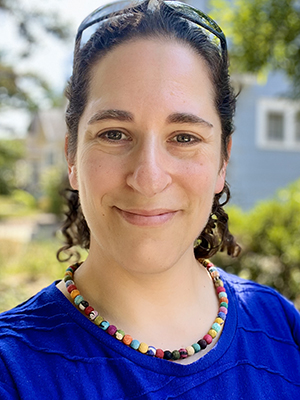Emmy Higgs Matzner is the lab manager of the Child Brain and Perception Lab, directed by Dr. Charisse Pickron, in the Institute of Child Development. Currently, Emmy is helping to conduct the study Gender and Race Associations in Babies with toddlers and infants at CDLS. Marie Lister, director of teaching and research at CDLS, sat down with Emmy to talk about her experiences conducting research at the school and how what she’s studying now could impact the way we understand and support children’s development in the future.

ML: Can you tell us about the research project that you’re conducting right now?
EHM: It’s called GRAB, which stands for Gender and Race Associations in Babies. We’re exploring if babies and toddlers are showing any early race-based associations when prompted to choose dolls, markers, and faces of different skin tones. We’re also investigating if older toddlers are more likely to choose the skin tones that correspond to the race of their caregiver(s).
How do you think this research will be useful to children and families?
Hopefully this will inspire additional conversations at home and in the classroom about what toddlers are already noticing about people they see or do not see on a regular basis. Often there is an assumption that infants and toddlers are too young to make associations or have preferences for people based on a particular feature or label. Through this work we hope to highlight that toddlers are engaging with their world and are actively formulating their own ideas based on verbal, visual, and social experiences.
We know that by five years of age, children express preferences based on a number of social categories such as race, gender, spoken language, and even material things like the color of someone’s shirt. Thus, we want to explore what types of experiences and skills are leading up to these biases. We hope that the more we understand what toddlers are noticing and making decisions about, the better we can support reducing the presence of social biases in later childhood.
How has your experience been working at CDLS?
We love working with CDLS teachers, staff, and children! We didn’t know a lot about the school before starting this project, and it’s been neat to get a glimpse of this renowned center. Folks have been very welcoming and have helped us align our research interests with the values of CDLS. It has been so rewarding working with the classroom teachers. With their expertise, we have gained useful feedback for strategies to improve working with the children.
Any advice for someone coming to do research at CDLS?
There are a number of useful documents on the CDLS website as well as many helpful staff members who can guide you. First and foremost, focus on building relationships with administrative staff, teachers, and children. Ask questions and enter the space humbly as a learner, not just a researcher with an agenda. Think about how you can conduct your project in a way that’s conducive to the day-to-day flow of the classroom.
Is there anything else you’d like to share?
We had a great time partnering with CDLS! We’re grateful for everyone’s openness and support. We hope to partner again in the future and learn what research would be most beneficial to their teachers and families. For our current Child Brain and Perception Lab studies, we’re recruiting children who are 10-24 months old and four to six years old. Email us at cbplab@umn.edu if you want to participate!
